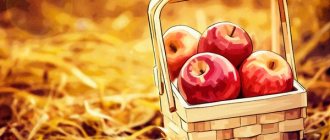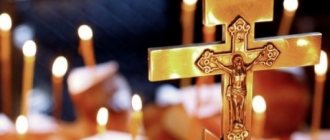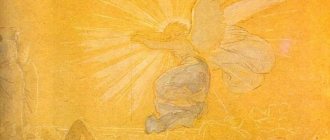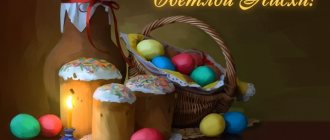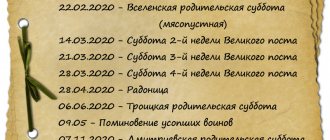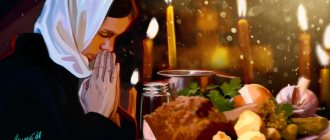Palm Sunday is the popular name for the holiday of the Entry of the Lord into Jerusalem . Western churches call it Palm Sunday ; in Orthodoxy the name Palm Sunday has been established.
Western churches have already celebrated Easter, and for churches living according to the Julian calendar , an important period begins - the tragic and mournful Holy Week , preceding the Bright Resurrection of Christ .
The last holiday before Holy Week is Palm Sunday; in 2021 the holiday falls on April 25 . on May 2 this year .
When is Palm Sunday in 2021
Palm Sunday is a temporary Orthodox holiday. Every year it is celebrated on different days - the date depends on the date of Easter.
The date of Easter is determined according to the lunar calendar. Thus, the holiday occurs on the first Sunday after the full moon, which began following the spring equinox. Every year the spring equinox occurs on March 20th.
Palm Sunday comes to the house exactly a week before Easter. Therefore, in 2021 the Orthodox will begin on April 25th.
The essence of the holiday
Almost any modern holiday has a generally accepted name. However, in the case of Palm Sunday the situation is different. The holiday has several names, each of which carries a special meaning.
Several other names for Palm Sunday:
- Vaii Week - Translated from Greek, “vai” means palm branches.
- Dominica in palmis is a Latin name that translates to “The Lord's Day in the Palms.”
- Palm Sunday is a name used in several European countries.
There is a phrase often found in Russian liturgical books - Flower-Bearing Week. This is another name for the holiday, which arose after the residents of Jerusalem greeted Christ with flowers. The word "Week" in Church Slavonic means one day of the week - Sunday. In many countries, incl. in the Russian Federation, palm branches are replaced with willow or willow branches. In Russia, these plants bloom first. The willow is also considered a symbol of forgiveness. If a person holds willow branches in his hands, it means that he forgives his offenders.
From the history of the celebration
According to the canons of liturgical books, the week preceding the holiday is called the Flower-bearing week, as well as the week of Vai. The history of the origin and celebration of the celebration is long-standing, described by the evangelists Matthew, Luke, Mark and John. The description of the event differs only in small details; in general, the narratives are completely the same.
In 30 AD, Jesus visited the small town of Bethany, located near Jerusalem. There his disciples took a young donkey and a donkey, while the owners of the animals did not interfere either by word or deed. Sitting on a donkey on top of the bedclothes, Christ heads to Jerusalem. People passing along the road loudly greeted Jesus, praising him.
On a donkey, Christ enters the gates of the city, while the townspeople shouted joyfully about the Savior. They threw clothes on the road and covered the path with palm branches, which was customary when meeting especially revered persons. It is no coincidence that Christ chose the donkey as an animal - an animal that was highly revered in the East as a symbol of peace. Generals traditionally rode into captured cities and settlements on horses and ornate chariots. Jesus showed that he was going to Jerusalem in peace, and the crowd enthusiastically welcomed the Messiah.
Christ expelled merchants and moneylenders from the city temple, miraculously healed the blind and lame who turned to him, and after all he left the city, going back to Bethany. The Jews recognized Jesus as the Savior, rejoiced and rejoiced, and only Christ himself knew that in a few days these same townspeople would demand his death. The symbolism of the holiday lies in faith in goodness, in condescension towards human thoughts and actions, in forgiveness.
As a festival, the event has been celebrated since about the 4th century. This is evidenced by records in the works of Epiphanius of Cyprus, images on ancient sarcophagi of the 4th century. Celebrated in Orthodoxy, Catholicism, as well as by believers of the group of ancient Eastern churches and Protestants.
history of the holiday
The history of the holiday has two versions - Christian and pagan.
According to the Christian version, in 30 BC. The surroundings of the city of Jerusalem were excited by a rumor about an unknown wanderer who heals terminally ill people and even resurrects the dead. It was rumored that the blind would become sighted again, and lepers would gain healthy skin. However, the most amazing event was considered the resurrection of the righteous Lazarus, who died a few days ago, but emerged from the grave alive and unharmed. Because of these actions, Jesus was called the Savior and the Messiah.
The day after performing the miracle of healing, Jesus went to Jerusalem. The residents of the city had heard a lot about the miracles performed by the Savior. When Christ entered the settlement on a donkey, thousands of people began to greet him shouting: “Hosanna!”, which translated means “Save us!” People hoped that Jesus would become king of Israel and deliver the people from Roman rule. Residents threw palm branches and flowers at the donkey's feet. The ruling Jews, in turn, also covered the animal’s path with date palm branches.
Trying to show their benevolence, the Jewish high priests were not happy about the arrival of Christ. The Savior felt what torment he would have to go through. A week later, he was accused of an attempt on the royal throne, and then the people who had recently welcomed Jesus crucified him on the cross.
The Church approved the feast of the Entry of the Lord into Jerusalem in the 4th century. In Rus', the celebration began to be celebrated only in the 10th century.
According to the pagan version, the holiday of Palm Sunday is associated with Willow Whip, an ancient festival of fertilization. In paganism, close relationships between a man and a woman were not considered something shameful. On the contrary, the connection between people was perceived as a manifestation of a Divine act. Thanks to him, children were born who became warriors, healers, teachers and keepers of the hearth.
The act of fertilization symbolized a special ritual when young boys whipped girls on the legs with willow. The same was done with livestock. Pagans have always used willow in their rituals, because... she was a symbol of fertility and mighty strength.
Palm Sunday. Holiday event
triumphal entry into Jerusalem was preceded by the miracle of the resurrection of Lazarus from Bethany. We find a touching account of this event in the Gospel of John. When Lazarus fell ill, his sisters Martha and Mary immediately sent to tell the Savior about this. Lazarus soon died and was buried, and only four days later the Lord came to Bethany. “Lord, if you had been here, my brother would not have died!” said Martha. The Savior replied that Lazarus would rise again, and went to the cave where he was buried. When the stone was rolled away, the Lord prayed and then cried out in a loud voice: “Lazarus, get out!” And Lazarus, entangled in burial shrouds, came out of the tomb in which he had lain for four days.
Icon "Resurrection of Lazarus". Veliky Novgorod, XV century
The Lord has raised the dead before, soon after death. But this miracle especially shocked all those present, because the smell of decay was already emanating from the deceased, he was buried and lay in the coffin for several days. Many who saw and heard about this event believed in Christ.
When the next day the Savior entered Jerusalem, where many pilgrims had gathered before the Old Testament Passover, He was greeted as a winner. The scribes and high priests, who were looking for the slightest reason to kill Jesus Christ, wanted to kill the resurrected one. Lazarus went into hiding and subsequently became the first bishop of Cyprus. He lived another 30 years.
The entry of the Lord into Jerusalem and his solemn meeting are described by all four Evangelists. The disciples, at the command of the Lord, brought to him a donkey and a colt, on which they laid their clothes, and He sat on top of them. Many people, having learned about the great miracle, met the Savior: they spread their clothes on the road, others laid cut branches. Those accompanying and greeting them loudly exclaimed:
Hosanna to the Son of David! Blessed is He who comes in the name of the Lord! Hosanna in the highest!
The donkey and the colt, which had not yet walked under saddle, symbolized the Old Testament Israel and the pagans who also believed in Christ. Evangelists point out that Jesus Christ, as the Son of David, enters Jerusalem on a young donkey, just like David after his victory over Goliath.
The people greeted Christ as a winner and triumphant, but the Lord did not go to Jerusalem for earthly power, not to free the Jews from the power of the Roman invaders. He went to suffer and die on the cross. Holy Week begins on Palm Sunday. Only a few days will pass, and many people will gather again. But this time the crowd will shout: “Crucify, crucify Him!”
Traditions of celebration in ancient times
In the pre-Petrine era, during the holiday, a chariot with a willow tree decorated with flowers, dates and nuts was installed near the Place of Execution. After this, the patriarch’s ceremonial entry took place from the Assumption Cathedral in the Kremlin to Lobnoye Mesto. The procession symbolized the entry of Jesus Christ into Jerusalem.
Arriving at the Place of Execution, the patriarch presented the king with a branch of a date palm. After this, the clergyman mounted a horse, decorated with red cloth in front and green in back. The king personally led the horse by the reins, in front of which was a chariot with willow.
The Patriarch reached the Assumption Cathedral and blessed the tree there. The largest decorated branch was cut off from the willow, cutting off several small twigs from it. All branches were laid out on trays and sent to the sovereign’s chambers, and were also distributed to the boyars and clergy.
People of lower rank and the royal court received their branches from sledges decorated with satin. Small branches were distributed to townspeople and archers. Anyone could take a few branches from the barrels placed around the perimeter of the square.
When Peter I came to power, he abolished the patriarchate and the procession on horseback. From that time on, celebrations were held on Red Square. The nuns of the Ascension Monastery created artificial flowers and figurines with their own hands, and then sold them along with willow branches. Folk festivals were held every year until the beginning of the 20th century. Orthodox people bought willow, sweets, flowers and toys, and then went to church to consecrate the branches.
Entry of the Lord into Jerusalem. Icons
Images of the Savior riding on a donkey are already known in early Christian art.
Entry of the Lord into Jerusalem, fragment of a fresco. Vysoki Decani Monastery, Serbia, XIV century
Almost all images of the Entry of the Lord into Jerusalem have a common compositional scheme, but differ significantly in details. Christ, blessing with his right hand, sits on a donkey, He is accompanied by two apostles talking with each other. One of them, according to a stable iconographic type, is identified as Peter, while the second apostle, quite young, may be Thomas, Philip or John. At the bottom of the compositions children are depicted rejoicing at the coming of the Savior. An indispensable element of the holiday’s iconography is the image of the Mount of Olives.
Entry of the Lord into Jerusalem. First half of the 16th century Museum named after Andrey Rublev
A significant change in the iconography of the Entry of the Lord into Jerusalem occurs in the 14th - early 15th centuries. Now the Savior is most often presented in a complex perspective - turning back to the apostles. The pose of Christ in question is present on icons from the festive row of the iconostasis of the Annunciation Cathedral of the Moscow Kremlin, the Assumption Cathedral of the Kirillo-Belozersky Monastery, tablet icons from Novgorod and many others.
Entry of the Lord into Jerusalem. State Tretyakov Gallery, Moscow, XVI century.
Entry of the Lord into Jerusalem. State Tretyakov Gallery, Moscow. Mid-15th century
In Pskov images of the 16th century, the Savior is represented sitting feet first, and his left shoulder is turned towards the viewer so that He enters Jerusalem almost with his back forward.
Entry of the Lord into Jerusalem. Pskov State United Historical, Architectural and Art Museum-Reserve. First half of the 16th century
Palm Sunday in Russia modern celebration traditions
Orthodox people living in Russia celebrate Palm Sunday every year. On this day, all believers should rest or take part in a religious procession. All the strictures of fasting on this holy holiday are weakened.
Many Christians celebrate the holiday with the whole family. On this sacred day, it is advisable to visit guests and give small gifts. The first thing you should do is visit friends and family. You cannot work on Palm Sunday. Any work is not only not encouraged, it is considered a sin. On this day, women are not advised to do housework, especially sewing or knitting. Sharp needles and knitting needles will attract misfortune to the house.
Christians prepared for the holiday in advance. On the eve of Holy Sunday, they collected branches of willow growing on the shore of the nearest reservoir. If the weather outside was bad, they put the branches in water so that the buds would have time to bloom before the holiday.
All branches consecrated in the church after the service turned into a talisman for the entire next year. Willow was used to decorate walls and icons, and a year later it was floated down the river or buried next to the house.
Properties of the blessed willow
A consecrated willow becomes a shrine. She has miraculous powers throughout the year. The church recommends keeping it in the house near the icons until next Palm Sunday. This helps to attract health, prosperity, and good luck.
You cannot throw twigs in the trash. This can lead to illness and money problems. Used or worn out willow can be:
- let the river flow;
- burn separately from garbage;
- bury in a clean place;
- put between the bushes of growing young willow;
- use to expel evil spirits and cleanse the house - set fire to a twig and walk around all corners of the room with it;
- give it to the nearest temple, where they will burn the willow with prayer.
Rituals on Palm Sunday
There are several ancient rituals that have survived to this day.
The most popular of them is to lightly hit your relatives and pets with a bunch of willow. Blessed rods relieve various diseases and the evil eye. Touching a person with the rods, people uttered the phrase: “Be as healthy as a willow.” In addition to the traditional “beating,” Christians bathed children in a decoction of willow buds and also treated women for infertility. If a person had a headache, then a branch was applied to the forehead. For pain in the joints, a branch was tied to the sore spot.
Before the holiday, women baked flour balls into which they placed kidneys. All close people were treated to this pastry. It was believed that the treat would bring health to a person and help women conceive a child. The balls were also given to livestock to keep them healthy.
If a believer dreams of becoming stronger and more self-confident, then in the morning after waking up he needs to drive a willow peg into the wall of the house. This ritual was supposed to rid a person of timidity.
If a young girl liked a guy and wanted to marry him, then on the morning of Palm Sunday she had to imagine dating her chosen one. In the evening of the same day, the guy came to the girl’s house to invite her for a walk.
To become rich, people planted indoor flowers on Palm Sunday. It is believed that the plant will “attract” money to the house on the same day. If the flower withers in the first month, then the person will be poor for the rest of his life.
Temples in honor of the Entry of the Lord into Jerusalem
In many ancient cities, churches in honor of the Entry of the Lord into Jerusalem were built in the 14th–15th centuries. To this day, they have survived mainly in a reconstructed form. Thus, the temple in Veliky Novgorod, built in 1336 by Bishop Vasily, was dismantled “due to disrepair” in 1759. At the same time, construction began on a new cathedral designed by the architect Rastrelli. The building has survived to this day and houses a lecture hall.
The building of the temple in honor of the Entry of the Lord into Jerusalem in Veliky Novgorod
Often the temple was not independent, but was considered a chapel of the main city cathedral, even if it stood separately. Perhaps this is connected with the rite of “procession on a donkey”? With the time of the emergence and spread of this custom in Rus', the construction of churches in honor of the Entry of the Lord into Jerusalem or chapels in Moscow (the western chapel of St. Basil's Cathedral), Ryazan, Kashin, Kazan, Suzdal and other cities coincides.
The rector of the Yuryevets Povolzhsky Cathedral (now Ivanovo region) was Archpriest Avvakum. True, he served there for a short time, only eight weeks. The new archpriest was so strict with his flock, trying to correct people who were accustomed to a dissolute life, that they beat him almost to death! The governor posted guards around the house and did not allow the massacre to be completed. The rebellion did not subside, and Archpriest Avvakum was forced to flee to Kostroma, and then to Moscow, where he later served in the Kazan Cathedral on Red Square. And the cathedral in honor of the Entry of the Lord into Jerusalem in Yuryevets was rebuilt in the 18th century and has survived to this day.
Next to the bell tower there is a five-domed cathedral in the name of the Entry of the Lord into Jerusalem (rebuilt at the end of the 18th century). Archpriest Avvakum was its rector for a short time. Yuryevets Povolzhsky. Photo by S. M. Prokudin-Gorsky, 1910
In honor of the Entry of the Lord into Jerusalem, the chapel of the Assumption Cathedral in the city of Belozersk, Vologda Region, . The church was built by 1553. The architects and builders of the cathedral were Goryain Grigoriev Tsarev and Tretyak Borisovich Rostovka. The Assumption Cathedral of the Kirillo-Belozersky Monastery was chosen as a model for the construction of the Assumption Church. A legend has been preserved that in 1613 the Assumption Church was destroyed and desecrated by the Poles, who kept horses in it and lit a fire.
Assumption Cathedral in Belozersk, Vologda region
In honor of the Entry of the Lord into Jerusalem, the chapel of the Annunciation Cathedral of the Moscow Kremlin . At the turn of the 13th-14th centuries, on the site of the existing cathedral, a wooden Annunciation Church stood on a stone foundation. At the end of the 14th century, a small white stone temple with a basement was erected instead. In 1484 the old one was dismantled and rebuilt. Construction of the new cathedral continued until August 1489. The Pskov architects who built it managed to give the temple an impressive appearance, perfectly combined with exquisite decorativeness. In 1563-1564, by order of Ivan Vasilyevich the Terrible (1530-1584), the Annunciation Cathedral was rebuilt.
Annunciation Cathedral of the Moscow Kremlin
In honor of the Entry of the Lord into Jerusalem, the chapel of the Church of the Intercession on the Moat in Moscow . The Intercession Cathedral is located on Red Square, near the Spassky Gate and Lobnoye Mesto. Initially, a stone church of the Holy Trinity was built here, called “Trinity on the Moat,” because across the entire square along the Kremlin wall there was a deep and wide moat, filled up only in 1813. St. Basil, the Fool for Christ’s sake, was buried near this stone church . On October 1, 1554, by order of Ivan the Terrible, a wooden Church of the Intercession with seven chapels was consecrated in honor of the Kazan victory. It stood for less than a year and was dismantled, and a stone cathedral was laid in its place. Construction of the temple began in 1555. Its main part was erected by the autumn of 1559. A year and a half later, on June 29, 1561, the entire cathedral was consecrated, and this day became the date of completion of the temple. The exact date of completion of the construction of the Intercession Cathedral became known when restorers in 1957-1961 revealed the text of the temple “chronicle”, made in a circle at the transitions from the octagon to the tent and on the edges of the tent of the Intercession Church: “By the grace of God and the Most Holy Theotokos by the mercy and prayers of all saints By the command of the pious Tsar Grand Duke Ivan Vasilyevich of All Rus', the autocrat and under his noble children under Tsarevich Ivan and under Tsarevich Theodore, with the blessing of Macarius, Metropolitan of All Rus', this holy Church of the Intercession of the Most Holy Theotokos was completed in the summer of 7069, June 29, in memory of the saints and all-validated Supreme Apostles Peter and Paul in honor and glory of the Holy Trinity." This gives the date June 29, 1561, when the church was completed. In 1588, the tenth St. Basil's Church was added to it. At the end of the 16th century, figurative domes of the cathedral appeared - instead of the original covering, which burned down during another fire. Subsequently, the cathedral was rebuilt several times. In the second half of the XVI-XVII centuries. The Intercession Cathedral was the semantic center of the celebration of the Entry of the Lord into Jerusalem: a solemn church procession led by the Tsar and the Patriarch, called the “procession on a donkey,” headed to it from the Assumption Cathedral of the Kremlin. For four and a half centuries, the Intercession Cathedral witnessed all the significant events of Russian history: coronation processions and solemn religious processions took place next to it, state decrees were announced and petitions were drawn up, city life was in full swing around it.
Cathedral of the Intercession on the Moat in Moscow
There are no Old Believer churches consecrated in honor of this holiday.
What not to do on holiday
There are few prohibitions on Palm Sunday. However, all believers must adhere to them.
Orthodox Christians must adhere to the following rules:
- It is prohibited to cut willow branches from trees growing near the cemetery. It is also undesirable to prune a tree that has a hollow.
- It is forbidden to drink alcoholic beverages, use foul language or swear on this day. The holiday is celebrated modestly in a narrow family circle, without a noisy feast with songs and dances.
- It is strictly forbidden to work, but it is also prohibited to celebrate a holiday in an uncleaned home. This is why many women clean and cook on Saturday afternoon.
- The food on the holiday table should be modest. You are allowed to cook fish and drink a glass of red wine. Instead of homework, you should take care of yourself - get yourself in order, pray for yourself and your loved ones.
- There is a common but strange prohibition. It is believed that on Palm Sunday you cannot dye your hair or wash your hair. Otherwise, you can get yourself into trouble.
- Everything related to housekeeping and gardening should be postponed for a couple of days. It is only recommended to go out into the garden and stick a willow branch into the ground. This will help grow a rich harvest next year.
It is not recommended to hold funeral dinners on a holiday. The clergy do not strictly prohibit this, but advise rescheduling such events to any other day.
Palm or willow?
Why is it called Palm in our country? It is believed that this name was born due to the absence of palm trees, the branches of which are the main symbol of the significant event. Initially, if we talk about a Christian holiday, it was about the palm tree.
They took palm branches with them when going on a pilgrimage, as a symbol of the purity and righteousness of the upcoming journey. "Pilgrim" means " palm bearer ".
Palm branches in the Russian Orthodox Church were replaced by willow branches: this plant is the first to “wake up” in the spring, pleasing the eye.
But there is an opinion that with palm trees and willows everything is not so simple, and in our country Palm Sunday, the history of which begins long before the events described by the evangelists, has nothing to do with palm leaves.
Like many Orthodox celebrations, Palm Sunday has pagan Slavic roots .
The willow was considered a sacred plant by the Slavs; its branches and buds were endowed with magical properties and healing powers. She was the main attribute of the pagan holiday called Verbokhlest . The Slavs celebrated it cheerfully and crowdedly.
On a festive Sunday morning, they whipped (lightly) each other, children, and livestock with willow branches, uttering special spell phrases. This plant was believed to impart physical strength and courage. And at the same time it heals: dried buds, crushed into powder, were added to medicinal decoctions and baked goods.
There is a beautiful ancient legend: in ancient times, the willow was a woman with many children, which gave her reason to argue with Mother Earth herself about who was more fertile. As punishment for disrespect, the woman was turned into a willow.
Today, ancient Slavic traditions are intertwined with Christian ones, but believers, in anticipation of the Palm Sunday holiday, know exactly what needs to be done: prepare the treasured branches .
This is done the day before, and if the time for the willow to bloom has not yet arrived, the branches are brought in advance. Placed in water, they will have time to bloom by the long-awaited date.
In the old days, it was believed that it was better to choose branches from young bushes growing near rivers, but it was not recommended to do this near cemeteries.
What can you do on holiday?
All Orthodox Christians understand that on a sacred holiday they need to go to church, and do not forget to bring a sprig of willow from there. At the end of the service, the priest will bless the plant, which must be brought into the house and placed near the icon. To protect the house and all the residents living in it, you need to pray before going to bed and ask the Lord for theology.
If on this day you need to drive the cattle out to pasture, then you need to do this with a willow twig. Some Christians whipped bunches of cattle so that they would not get sick for the next year.
Those who are planning an important event need to eat three kidneys and believe that everything will work out in the best possible way. The kidneys should be washed down with holy water.
Women planning a child had to make an amulet from willow for themselves and for their husbands. The talisman helped them get pregnant quickly, and gave men strength and courage. Kidneys were even added to the feed of livestock so that they could actively reproduce.
Illuminated rods brought from the church were placed at the head of the bed on which the sick person slept. The magical power of the willow healed any ailment.
Traditions and rituals
There are many traditions and rituals associated with Palm Sunday. They are aimed at attracting health, wealth, prosperity, successful marriage, happy motherhood.
Modern traditions in Russia
Believers prepare for Palm Sunday in advance. A few days before the holiday, they cut young willow branches, bring them into the house and put them in water so that they bloom. It is worth choosing undamaged trees, where there are no hollows, broken or dried shoots. It is not recommended to use willow that grows near cemeteries or bodies of water. According to legend, evil spirits can rest on it.
Palm Sunday celebrations begin on Saturday evening. All-night vigils are held in churches. At the service, the priests read the Gospel, Psalm 50 and sprinkle the willow twigs with holy water. Parishioners stand with twigs and lighted candles until the end of the service. On Sunday, the Liturgy of St. John Chrysostom is held and the willow tree is consecrated again.
People bring the blessed branches home and place them near the icons. There is a tradition of whipping children and adult family members with them, saying: “I don’t hit, it’s the willow that hits!” or “Willow whip, beat me to tears!” People believe that such a ritual helps to cleanse oneself of the evil eye and evil spirits, and attract health, strength and prosperity.
Traditional healers prepare willow buds on this day. They believe that infusions from them help men maintain strength and women to conceive a child. Housewives bake pies from willow buds. It is believed that they help protect household members from diseases.
On this day, young girls cast love spells on their future husbands. They break several branches on a willow tree, tie them with red thread, make a wish for their betrothed and keep them behind the icons. You can’t throw away the bundle, as you could ruin the young man’s life and your own.
In some regions, the ancient tradition of organizing palm bazaars or fairs on this holiday remains. They host celebrations with colorful treats and entertainment for adults and children. Folk craftsmen sell handicrafts and cherubs - willow branches decorated with figurines of angels.
Ancient celebration traditions
Women who had small children bathed them in water with palm buds on Palm Sunday. They believed that such a ritual could save babies from illnesses and give the growing body health and strength.
Relatives of weak and sick people beat them on the body with willow twigs and at the same time said: “Holy Spirit, enter through the willow tree and take away the disease. The willow will come and the disease will take away.” It was believed that such a ritual would help restore health.
Housewives baked cookies with the addition of willow buds to become healthier and ward off illnesses from their families. Baked goods were also fed to livestock to increase the number of animals and protect them from diseases.
After the end of the church service, believers ate 9 willow buds to protect themselves from toothaches and illnesses.
On this day, people hammered a blessed palm stake at the corner of the house. They believed that he would help banish fears and make all family members more determined.
In the 16th-17th centuries, an annual religious procession took place in Moscow on Palm Sunday. The Patriarch of the Russian Orthodox Church and the Tsar took part in it. They rode through the city on a donkey. An important attribute of the holiday was a tree decorated with fruits. The fruits symbolized God's grace. They were distributed to everyone on Red Square after general prayer.
What you can and cannot eat on Palm Sunday
Before Palm Sunday, there is 48 days of Great Lent. Everyone who held it can relax and sit down at the table twice on the holiday.
As for the Lenten menu, it includes the following products:
- fish dishes (can be any: baked, boiled);
- fruits;
- vegetables;
- sweets;
- bakery.
Drinks include good red wine, but no more than 2 glasses. You are allowed to drink white wine, but only in moderation.
Accordingly, other foods and alcoholic beverages are prohibited. You cannot eat fatty, salty foods, fried meat, incl. chicken and turkey. Also, you should not drink strong wines, vodka and other similar drinks.
If a person does not observe Lent, then he can choose what to put on the festive table. The main thing to consider is that the holiday is intended for communication with family, and not for gluttony.
The most common dishes that guests were treated to in Rus' were:
- lean bread;
- flour balls;
- porridge;
- buckwheat pancakes;
- cookies.
All dishes must be prepared without using eggs, butter or milk.
Food on this day - what you can and cannot do
Palm Sunday falls during the Great Forty Days of Lent before Easter. On this holiday, the church gives a relaxation of fasting. It is forbidden to eat meat, eggs, dairy products, but you can eat fish.
Traditional holiday table treats include vegetable salads, stews with the addition of peas, beans, corn, beans, lentils, and porridge from a mixture of cereals. A popular product during fasting is mushrooms. Housewives make roasts, casseroles, pies, zrazy, soups, cabbage rolls from them. Mushrooms and legumes replace meat products. For dessert, housewives serve fruit, lean marshmallows, jam, marmalade, halva, dark chocolate, and cookies. Traditional drinks are jelly, compotes, and uzvars. On Palm Sunday you can drink a little red Cahors.
Folk signs and beliefs
The signs of Palm Sunday tell of the miraculous properties of consecrated branches. Customs prohibit the use of pine needles on this day - they are intended for burying the dead.
There are several folk superstitions about twigs:
- If on the day of the holiday you make an amulet from the kidneys with your own hands, then very soon a person will go on a long journey or journey.
- Collecting several branches with unopened buds means moving up the career ladder.
- If a barren woman finds a twig on her doorstep, it means that she will soon be able to get pregnant.
Signs about the weather have been passed down from older generations to younger ones for many centuries. They also told people when to expect the harvest.
Signs about the weather and harvest on Palm Sunday:
- Sunny and windless weather portends a warm summer and a good harvest.
- A morning without frost means an abundance of fruit.
- The more flowering earrings there are, the more abundant the harvest will be.
- Cool but clear weather means a good spring harvest.
- Windy weather means cold summer.
- It was frosty at night - cabbage and cucumbers will grow in summer.
- It rains in the morning - a bountiful harvest of all crops.
- Suddenly, severe frosts hit - the wheat will not be harvested this year.
- The wind blows from the north - the year will be fertile.
Often on holiday the weather was changeable. If a storm started, people threw several buds against the wind to stop it.
Many people dreamed of becoming rich. To do this, they removed all the old things and objects from the house, making room for new items. Many people planted a “money” tree in a pot and carefully cultivated it. It was believed that the larger the tree, the more benefits a person will attract into his life.
On this holiday, debtors need to pay off all their debts and celebrate Palm Sunday with a “light heart.” Repayment of the debt, in turn, cannot be demanded.
Young girls dreamed of getting married successfully. To ensure that the future husband was generous and faithful, the girls prepared treats and went to feed the poor on holiday. To attract a groom, single ladies would do embroidery on pillows in advance. It was believed that the pillow would attract a lover to the house on Palm Sunday.
Palm Sunday in different countries
In different countries, the celebration of the Lord's Entry into Jerusalem is carried out differently.
In Italy the holiday is called “Palm Sunday” or “Olive Day”. After a church service, it is customary to give olive branches to loved ones. Olive is also given to those with whom they want to make peace after a quarrel. Residents of Italy attach branches to houses, boats and carriages as a sign of respect for Jesus Christ.
In France, the holiday is called “Blooming Easter”, but people from different regions call this day differently. For example, in Provence Palm Sunday is called “Hosanna Sunday,” and in Picardy it is called “Easter with boxwood.” Early in the morning, the French consecrate the branches of a palm tree, rosemary, boxwood or laurel. After this, the branches are attached to the head of the bed or to the fireplace. During a thunderstorm they are used as sprinklers.
In Catalonia, on the morning of the holiday, markets open on the streets where people can buy branches. The children take the branches to the priest to bless them. Godfathers and mothers give their godchildren sweets and gingerbread cookies with the image of Jesus Christ.
Germans and Austrians consecrate branches of juniper, beech or holly on this day. The decorated bundles are carried to church and then placed in the house or garden. A few rods are also nailed in the bedroom and shed.
On Palm Sunday, Macedonians and Serbs gather in groups and go “house to house.” Girls wear beautiful white dresses and decorate their heads with bright scarves. Decorated baskets and large knives are used to collect gifts. The guys walked around all the houses, stopping in front of each one and performing dances for the residents.
In Greece, instead of willow branches, greenery was blessed in the church. Women tied greenery (vaya) into bunches, and after visiting the temple they blessed the house and the entire household with them. At the end of the holiday, the vayu was taken to the cemetery.
Entry of the Lord into Jerusalem. Festive service
In the stichera for the holiday, first of all, the humility of the Savior is pointed out, modestly walking on a dumb foal, and the believers are called upon to greet the Coming One with jubilant singing: “Blessed is He who comes in the name of the Lord, Hosanna in the highest.” The texts of the Orthodox service not only describe the events that took place in Jerusalem two thousand years ago, but also show us their significance, in particular, the fulfillment of Old Testament prophecies. The first proverb (Gen. XLIX, 1-2, 8-12) contains the prophecy of the patriarch Jacob to the son of Judah that kings will come from his family until the Reconciler appears (i.e. the Lord Jesus Christ); in the second proverb (Zephaniah III, 14-19) the triumph of Zion and the rejoicing of Israel are prophesied, because the Lord, the King of Israel, is among them. The third proverb (Zechariah IX, 9-15) predicts the triumphal entry of Jesus Christ into Jerusalem on a colt:
Your king is coming to you, righteous and saving; He is meek and sits on a colt and a young donkey.
The canon depicts the joy of true Israel, honored to witness the Royal Entry of the Lord into Jerusalem, and the anger of the scribes and Pharisees and high priests of the Jews with which they looked at the triumph of the Son of David. All living things are called to glorify the Lord, who goes to free and saving suffering.
Library of the Russian Faith Canon of Palm Sunday →
Read online
The evening service has a feature that distinguishes this holiday from others: after the Gospel, the priest reads a prayer over the willow tree, in which the dove that brought Noah an olive branch is remembered, and the children who met Christ with the branches with the words: “Hosanna in the highest! Blessed are those who come in the name of the Lord.” Having venerated the Gospel, the worshipers receive from the priest several branches of consecrated willow and hold them in their hands along with burning candles for the rest of the service. Returning home, believers place the willow next to the icons. It is not customary to throw away last year’s “bouquets”; they are burned or thrown into the river.
In the Apostle (Phil. IV, 4,-9) believers are called to meekness, peacefulness, a prayerful mood and fidelity to the teachings of Christ. The Gospel tells of the Lord's entry into Jerusalem (John XII: 1-18) and of the supper in Bethany.
The troparion of the holiday explains to us the spiritual meaning of the Lord’s triumphal entry into Jerusalem:
The general sunrise before your passion ўwersz, and 3з8 dead waters є3сi2 lazarz хрте b9е. the same and3 we2 ћkw џtrots, victorious џimages of the nossche, to you the conqueror of death we cry, nsanna in 8 blissful lands in 2 and 3mz.
Russian text:
Confirming the general resurrection before Your suffering, You raised Lazarus from the dead, O Christ God. That is why we, like children, wearing symbols of victory, say to You, the Conqueror of death: Hosanna in the highest! Blessed is he who walks in the name of the Lord!
Kontakion for the holiday. Church Slavonic text:
On the planet on the nb7si, on the lot on the earth2 carry1m xrte b9e, t ѓnGl praise, and3 t dеtє1st chanting of the reception, calling you, blessed є3si2 come ґdam to move.
Russian text:
Christ God, carried on the throne, and on earth on a donkey, You, received chanting from the children and praise from the Angels crying: “Blessed is the Lord, who comes to call (from hell) Adam.
Congratulations, chants
Divine services on the day of Palm Sunday never take place without the performance of troparions. In churches they perform:
- “Burning You with Baptism”;
- "General Resurrection";
- Psalm 50.
After the solemn part in the church they continue to sing the one-line magnification “We magnify You, Life-Giving Christ.”
Don’t forget to send short SMS messages to your loved ones on this day with congratulations in verse.


